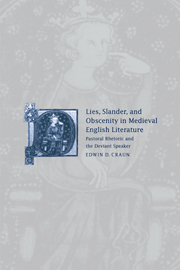 Lies, Slander and Obscenity in Medieval English Literature
Lies, Slander and Obscenity in Medieval English Literature Published online by Cambridge University Press: 31 October 2009
THE PASTORAL “BATTLE OF OUR LORD AGAINST THE VICES”
As literacy increased among Western Europeans in the eleventh and early twelfth centuries, so, Brian Stock argues, did scripturalism, the practice of using the written word to establish norms and values and so to control conduct. Then scripturalism was used to shape fairly small reformist communities like the Cistercians and the followers of Peter Waldo: “textual communities.” In the thirteenth century, beyond the reach of Stock's studies, the Fourth Lateran Council (1215) and its offshoots, local synods, designed a movement of pastoral care to practice scripturalism within a far larger community: the entire Western Church. Its cadre of religious teachers were parish priests and mendicants, evangelists whose orientation differed greatly from that of the inward-looking monks who had dominated the church in the preceding centuries. Its central texts were catechetical formulas like the Creed, the Seven Works of Corporeal Mercy, the Seven Sins, and, behind them all, the Christian scriptures. Its basic scripturalist activities were preaching, directing confession, and admonishing individuals. This movement also produced its own texts, pastoral writing which presented catechetical material for priests to use in the religious/social formation of themselves and the laity.
Although vast in quantity and varied in type, this pastoral literature constructs a “corporate social definition” of sin, one for all Christians to know and to use in governing their conduct.
To save this book to your Kindle, first ensure [email protected] is added to your Approved Personal Document E-mail List under your Personal Document Settings on the Manage Your Content and Devices page of your Amazon account. Then enter the ‘name’ part of your Kindle email address below. Find out more about saving to your Kindle.
Note you can select to save to either the @free.kindle.com or @kindle.com variations. ‘@free.kindle.com’ emails are free but can only be saved to your device when it is connected to wi-fi. ‘@kindle.com’ emails can be delivered even when you are not connected to wi-fi, but note that service fees apply.
Find out more about the Kindle Personal Document Service.
To save content items to your account, please confirm that you agree to abide by our usage policies. If this is the first time you use this feature, you will be asked to authorise Cambridge Core to connect with your account. Find out more about saving content to Dropbox.
To save content items to your account, please confirm that you agree to abide by our usage policies. If this is the first time you use this feature, you will be asked to authorise Cambridge Core to connect with your account. Find out more about saving content to Google Drive.